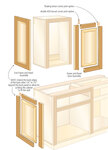We may receive a commission when you use our affiliate links. However, this does not impact our recommendations.

You can make your own wiping varnish by thinning any full-strength varnish or polyurethane about half with paint thinner.
Recently, I had an exchange with a friend who does woodworking as a hobby, and the exchange made me realize that the need to thin oil and varnish, especially varnish, and including polyurethane varnish, can seem confusing. So I thought I would address this topic of thinning in this post.
First, there’s no need to thin the first coat of either oil or varnish to get a better bond to the wood. Oil and varnish dry very slowly and have plenty of time to penetrate well into the wood. I know that many people believe that thinning is necessary, especially with varnish, and especially in the wooden-boat finishing world, and it doesn’t hurt anything to do this. But it only achieves having to apply more coats to get the build you want. Have you ever seen a case of varnish peeling from wood that was clean and sanded when the varnish was applied except where water has gotten underneath the finish? Thinning the first coat won’t prevent water from getting underneath if it can find a way.
Second, and on the opposite side, thinning varnish can be helpful in reducing or eliminating brush marks with varnish, especially after the first coat when you’re building a thickness. This is not true with oil because all the excess oil has to be wiped off before it dries. There shouldn’t be any brush marks with oil. Adding about 10 percent thinner to varnish is usually enough to get varnish to level out. It doesn’t take much.
Third, the product that I call “wiping varnish” that is often labeled tung oil, Seal-a-Cell, Salad Bowl Finish, Pro Fin, Val-Oil or some other unhelpful name, is typically varnish or polyurethane thinned about half with mineral spirits (paint thinner). It’s not thinned to make it bond better to the wood, but to make it easy to wipe on and wipe off. It’s applied much like oil, but because it dries hard, the excess doesn’t have to be entirely wiped off. You can get a build after several coats.
Here are some supplies and tools we find essential in our everyday work around the shop. We may receive a commission from sales referred by our links; however, we have carefully selected these products for their usefulness and quality.










